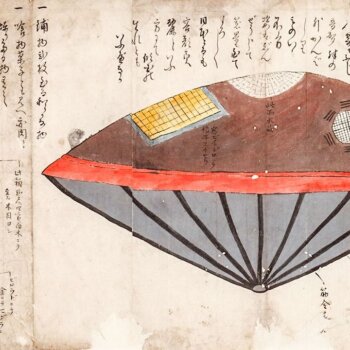Key Takeaways:
- Whether “wrong color get you killed” or “street pajamas get you laid”, clothing is—for most of us—a form of conscious projection: of our values, wealth, aspirations and affiliation.
- For some, the drive to wear one’s inner life on the outside isn’t a function of culture, religion or socio-economics.
- Others’ clothing choices can bring out the best in us, or the worst.
“And they were both naked, the man and his wife, and were not ashamed.”
So said the god of the monotheistic faiths in the close of Genesis Chapter 2, referring to his creations, Adam and Eve. Alas, it didn’t last. As we know, Eve bit the apple (of sexual knowledge), turning their child-like innocence into full-blown adult hunger.
And thus, newly ashamed, they left Eden, sporting fig leaves.
Of course, it’s just a story. For those who believe the world is older than Judaism, the same went for early humans.
More Than Cover
Over the millennia, clothing has evolved beyond simply shrouding genitalia to become a powerful force in shaping a life. Clothes are an expression of our most deeply held beliefs, and simultaneously, worn to protect against our greatest fears.
There are many dimensions to the choices we make when we clothe ourselves today. These include cultural signification, group cohesion, socio-economics and self-expression.

Cultural Signification
The most obvious influence on clothing’s form was to protect its wearer from the elements. From shoes to head coverings, pragmatism was the seed of early dress, adapting itself in response to the local biome, and the raw materials and technologies available. Deserts demanded light-colored, loosely draped clothing to dissipate heat and encourage air flow. In the Arctic, thickly bound animal skins and fringe protected us from bitter cold and wind.
Eventually, people came to associate regional apparel with the cultures in which they became dominant. Then, something funny happened. By simply dressing like other ‘locals’, we developed a form of in-group affiliation, our unconscious biases favoring our similitude. However shallow it may feel to connect with someone else over fabric, it was, in fact, a very powerful catalyst for one of our most important psychological needs: belonging.

Group Cohesion
We are an inherently social species. We find ourselves psychologically by observing other people, then exploring where we fit in relation to what we have observed. Some would say there is no self without others, since “self” is a relative term—useless without applying it in the context of social living.
Belonging—finding oneself in the company of a group—is one of three foundational drivers of human activity: giving and receiving love, belonging by way of social acceptance, and finding and executing one’s purpose.
As a result of our central need to feel accepted by others, the pressure to fit in is potent. This is why we encounter fashion stereotypes everywhere. It’s not for lack of human creativity or lack of choice that we shroud ourselves like our peers. It’s because looking like others—like those we admire or aspire to emulate, or toward whom we feel an affinity—is one way to express that connection, whether it’s fact or fancy. In contrast, dressing conspicuously—in contravention of conventions and customs—risks putting us at odds with the groups we encounter, where we risk of being rejected, or even punished.
You need to look no further than your typical school to see group dynamics at play. Kids excel at making fun of others who dress (or act) differently. It drives them to harassment more often than not, and on occasion, violence. Few children I know, both from memory of my own childhood and from observing my three teenage muggles, value unbridled self-expression over fitting in.
According to Dr. Stephanie Newman, Ph.D.:
“Girls use clothes, accessories, and fashion to define themselves, make statements about their choice of peer group, and to establish their psychological identities. For some, the right outfit can serve as a conduit to the popular clique. For others, clothing choice allows them to fly under the radar. It might even make the difference between fitting in or opting out of her school community entirely.
They readily acknowledge that they dress to fit in with friends. In teen world a fashion faux pas has the potential to bring about social ruin, and to become a set-up for insults and ridicule.”
There’s even a term for it: “mirroring”. Newman writes:
“If someone feels unsure but sees him or herself reflected back in another’s appearance, words or actions — say in identical clothing — that person feels pumped up, less insecure.”
Adults are no different. The stereotypes abound: hipsters; lawyers; hippies; rappers; jocks; Stepford wives (see photo, above). We can picture every one of them, as clear as day.
It’s quite something to walk down the street in NYC’s East Village today—on St. Marks Place, in particular. It overflows with mohawks, punk-themed t-shirts and studded-and-ripped clothing. Most of these kids were born a quarter-century after punk died. And yet: in trappings older than they are, they find themselves belonging to the spirit of an aesthetic and ideology.
The drive to dress like others is a phenomenon we cannot ignore. And its apex expression—in codified behaviors and fervor—is found in religion.

Religion
The tall felt hats, white gowns and long skirts of the Whirling Dervish. Sikhs’ turban-wrapped tresses and flowing beards. The saffron robes and sandals of Buddhist monks. Hare Krishnas’ shaved heads and pony tails. Muslim women’s hijabs, burqas, niqabs and chadors. Chassidic jews’ payot and shtreimels.
You can spot them all instantly. And for all of them, the penalty for not dressing like everyone else can be severe: excommunication; flogging or stoning; imprisonment; even a rejection from their heaven.
Moreover, these signifiers are enough to cause wars between differently clad groups. Religious vestments are, in a sense, proxy uniforms for soldiers—like the U.S. Civil War’s “blues” and “grays”—worn not only so that we can recognize the enemy, but so that we can channel the strength of our deity.
“Therefore take up the full armor of God, that you may be able to resist in the evil day, and having done everything, stand firm.”
So says Ephesians 6:13.
Among the secular, the religious trappings of yesteryear have largely been outshone by the socio-economic ambitions of today’s “wars”.

Socio-Economics
It started in the U.S. prison system, where belts were taken from inmates and pant legs were rolled up to make sure that perps weren’t “packing heat”. Adopted in the early 90’s by hip-hop artists, it quickly became a symbol of street-toughness—a counterpoint to tailored wealth and buttoned up culture. “Sagging”, as it’s now called, initially polarized Americans largely on the fault lines of race, with white people on one side, and black people on the other. Though like everything else, once something normalizes, it loses its original association. With sagging, more people on both sides of the divide have taken to doffing their belts and letting their boxers fly, in acts of counter-cultural defiance.
Clothing is such a powerful force that it can be outlawed even in secular places, where at its extreme, it can become a death sentence. As reported in Forbes:
“When Shreveport had a “saggy pants ban” in place, Anthony Childs, a 31-year-old Black man, fled from a police officer who was trying to detain him for wearing his pants too low. The officer fired several rounds at Childs, who died during the confrontation. The death was later ruled a suicide.”
I recall a line from a song about L.A.’s Bloods and Crips, which went something like “Wrong color get you killed.”
At the opposite side of the spectrum, cultural appropriation and strange forms of wealth signaling reign. There are $425 pre-muddied jeans, so you can look like a “good ol’ boy”. There are $40,000 sneakers, which have turned utilitarian sportswear into haute couture. Body-hugging activewear (what I refer to as “street pajamas”) and oxymoronic “luxury gym clothes” take it—in my view—to a new level of inanity. These and other trends are just the latest iteration of socio-economic peacock-strutting.
Whether “wrong color get you killed” or “street pajamas get you laid”, clothing is—for most of us—a form of conscious projection: of our values, wealth, aspirations and affiliation.

Self-Expression
The clothes we wear serve another function, especially among those for whom the urge for self-expression—of divergence from social norms, even at the risk of judgment, harassment or ostracism—outweighs the need for group cohesion, religious adherence or socio-economic signaling.
Artists are primed for this type of behavior. From Dali and Kahlo to Prince and Kusuma, clothing has been used by the art community as a tool for the expression of one’s inner life, and/or exploration of self.
Increasingly, personal style is being accepted as an art form, outside of the mass-market fashion industry.

In one acute and wonderful example, the Sapeurs de Brazzaville reflect an emerging social trend toward extreme self-expression, as art. As reported by Al Jazeera:
“Like their impeccably dressed male counterparts, the female Sapeuses will spend in excess of $3,000 on a suit when they do not even have running water, and go without food in order to save up for the right designer accessories.”
For these people, like traditional artists elsewhere, their calling is to invest in their own art, even if the trade-offs (water/food/etc.) are high. They have elevated dressing to what can only be called an art form—one that is now deeply entrenched in the Congolese culture.
Back at home, codified in its Ten Principles, Burning Man is as much a festival of unbridled self-expression as it is anything else. Here, 75,000 people are free to explore their inner lives, wearing them outwardly—as I wrote upon my return last time—“like a peacock’s bombast.” Per the Org:
“Radical self-expression arises from the unique gifts of the individual. No one other than the individual or a collaborating group can determine its content.”
But even at Burn, sadly, fashion-self-consciousness and groupthink exist. While it’s best to ignore them, the legions of selfie-obsessed sparkle ponies and brand-building stardust vagabonds abound, reminding us that while radical acceptance is a currency to be spent freely on Playa, not everyone got the memo, or understood it.
For some, the drive to wear one’s inner life on the outside isn’t a function of culture, religion or socio-economics. Sometimes, it is an act of asceticism—of self-restraint, simplification or even penance.
Mo Gaudet is one such individual. While promoting his book Solve for Happy: Engineering Your Path to Joy, Google X’s former Chief Business Officer and I found ourselves as co-speakers at a conference. Between events, we chatted. Spurred by the death of his 21-year old son Ali, he was, at the time, on a personal quest to share insights gained on his quest to re-discover happiness—of living, again.
Smiling, Mo proudly told me he had sold everything he owned, and was now traveling the world in a small suitcase, filled with jeans and $8 Gap t-shirts. “What more do I need,” he offered, as though his fashion choices freed him from the strictures of grief—of the paradox of his powerlessness to save his son, in spite of his considerable wealth and influence.
Sometimes, the abandonment of expectations—his book’s central premise—become the cherished path to freedom.
An $8 t-shirt led Mo home.
Final Thoughts
How we dress is anything but benign. It is an expression of our inner lives—our dreams, fears and values. Our choices can open doors, or close them. Empower us, or get us killed. Others’ clothing choices can bring out the best in us, or the worst. Our choices can literally shape a life, inasmuch as they can reflect one.
From Eve’s post-apple shame to the Sapeurs of Brazzaville’s pride, the trappings we choose are as complex and as rich as the psychology of the minds from which they stem, and for which they are the ultimate expression.





























